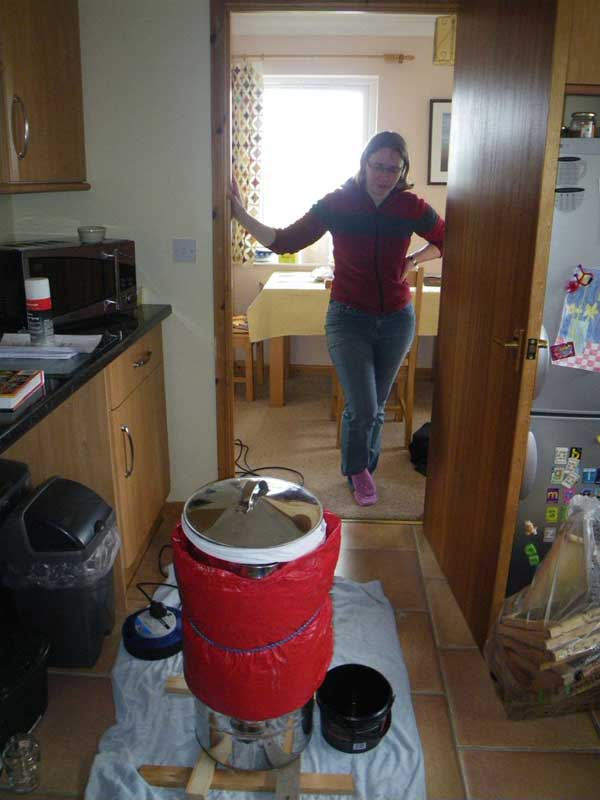Building a Bee Hotel
I’m not really sure what brought it on but late on Sunday afternoon I suddenly had the urge to build a bee hotel. We’d already inspected our honey bees during which Moirgan was stung by one, but I persuaded him to come out into the garden again to help. It had warmed up a little now, our bees were busy around their hives and we started to make plans.
As well as Bumblebees and Honeybees there are 225 species of wild bees in the UK that are called ‘solitary bees’. These make individual nest cells for their larvae, often in small tunnels or holes These nests can be in the ground or in sandy banks, piles of sand, or crumbling mortar. Others use the hollow stems of dead plants such as brambles, or tunnels previously bored into dead wood by beetles. I’ver read stories of people who have constructed bee hotels and have recorded close to 100 different species of bee in a single garden. With the number of species of moth from our moth recording ever increasing, I thought it might be nice to see if we could attract and then identify some wild bees too.
A number of species are commonly seen in gardens, and they are very useful as pollinators. Bees in general are on the decline thanks to loss of habitat, a shortage of suitable nesting sites, modern agricultural practices, insecticides and other factors so giving them a helping hand has to be good too. It is easy for gardeners to encourage them. By drilling holes in dry logs or blocks of wood it is possible to create artificial nesting sites for a number of common species, particularly Mason Bees.
We rummaged through the shed and found some suitable bits of wood and before long what had been a modest plan for a bundle of hollow sticks on the pergola had developed into a full on garden carpentry project. Why give the local bee population a cheap and cheerful B&B when they can have a luxury 5 star hotel!
Out came the tools and we were soon measuring, chopping, glueing and nailing various bit of wood together.
- Bee Hotel Materials
- Hammering
- Nailing
- Glueing
Bee hotels don’t need to be too sophisticated, the bees simply need some 2-8mm diameter holes in which to nest. These should be clean and dry and protected from the worst of the elements. They should also be around 15cm in depth. It’s also best if they face South or South East so as to get the morning sun and are sheltered from the rain. We ended up building a long box with a sloping roof that overhangs the rest of the box. It was cobbled together from various bits of wood so isn’t perfect but should do the job.
- Bee Hotel Box
- Cobbled together
For extra protection and to make it look a little nicer we then covered this with roofing felt and attached it to the fence. The bee hotel should be at least a metre off the ground.
- Roofing Felt
- Attaching to the Fence
We then started chopping up bits of bamboo cane to provide some suitable nesting tubes. The nice thing about Bamboo is that each cane tapers along it’s length so once it is chopped up you end up with lots of tubes of varying diameters. Each species of bee will have a preferred diameter tube in which to nest so offering a range of different holes should cater for more species. Due to the bits of wood we had to work with our box ended up being 14cm deep so the canes were cut to fit this, as were various logs and blocks of wood. As I chopped the canes, Morgan cleaned out the holes in them and we started to provide nesting sites for the bees.
It was then time to get the drill out and make holes in the various wooden blocks and logs. Again, using a variety of drill bits provides for a range of different species. Some of the bees we might attract are tiny so holes down to 2mm in diameter were added. In had started drizzling as we were making the box and started raining quite heavily now so we didn’t quite get around to drilling many holes but will finish this off soon. We also realised just how many bits of bamboo, stick, logs and drilled blocks of wood we were going to need to fill our bee hotel. Maybe a smaller one would have been less ambitious as it will take a while to fill this one, but we’ll get there in the end. We’ll buy some more bamboo canes as they seem to work well and look good too. I’ll drill some more logs and block of wood and will add some sticks from other plants when I have some available. Cuttings from the Elder should work well too as will any other hollow stems that I come across. We’ll try to fill a few compartments with mud too as some bees will prefer that and maybe some with stones or drilled bricks too just to provide a greater variety of potential nesting holes.
We don’t know how well it’ll work, or how long it will take before any bees take up residence, but it was fun building it, will be fun filling it with nesting tubes and should be fun to check on from time to time to see if we have any tenants. We still have a way to go before it is finished and it may not be quite as elaborate as some of the bee hotels out there – take a look at these for some seriously swanky bee hotels – but it will do us for now and we’ll add to it over the coming weeks..
























Great job! Please let us know if you spot any bees moving in.